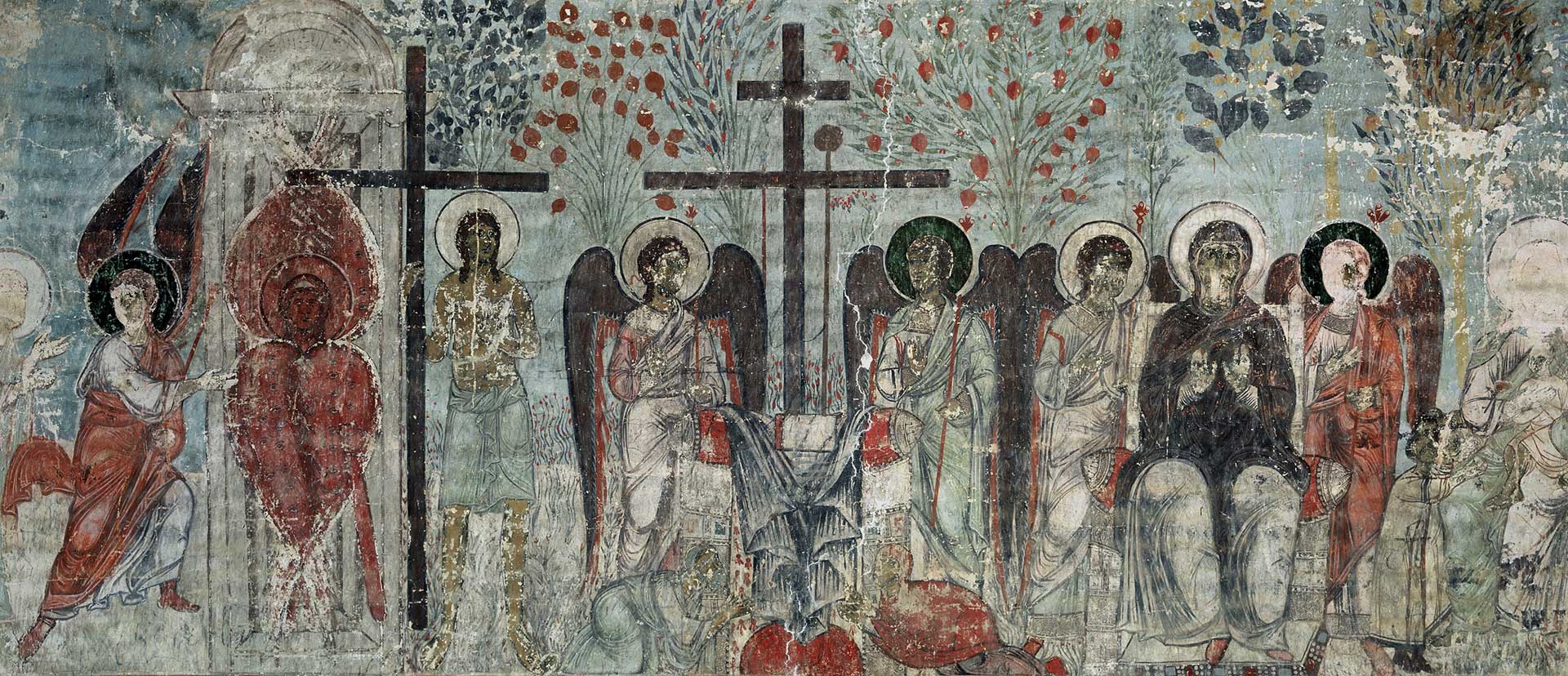
Feel free to add tags, names, dates or anything you are looking for


The church of the Virgin at Timotesubani is located on the bank of the River Toristskali in the picturesque Borjomi gorge, not far from the town of Borjomi itself in the historic region of Tori. In historic sources the monastery is referred to as Kimotesmani and was founded by Shalva Toreli, eristavt-eristavi, the chancellor of Queen Tamar.
.jpg)
Timotesubani, Church of the Virgin, general view from the south, (photo D. Khoshtaria)
The architecture of the church is dated to the turn of the 12th -13th cc. It belongs to the cross-in-square inscribed type, and is built of brick. The whole interior of the church is decorated with murals dating from the first quarter of the 13th c, and belongs to the group of wall paintings connected with the Golden Age of Queen Tamar.
The program of the wall paintings is based on the dogmatic idea of the Second Coming of Christ and that of Redemption through Christ’s self-sacrifice. In the sanctuary conch, under an image of the enthroned Virgin with Child flanked by Angels, there is a rare composition depicting the Donatio Legis (Christ delivering a scroll with His teachings to the Apostles), a long row of Holy Bishops in the lower tier, figures of the Prophets on the pilasters and figures of deacons in the windows.
.jpg)
Glory of the Cross, church of the Virgin at Timotesubani, painting in the dome (photo: G. Chubinashvili National Research Centre’s S. Kobuladze Photo Laboratory)
The grand composition of the Glory of the Cross is depicted inside the dome: a white cross adorned with pearls and jewels on the flaming red background of the mandorla decorated with stars is a sign of the Second Coming. The Cross is surrounded by seven figures of the Archangels and the Deesis in the eastern part.
.jpg)
Deesis, fragment from the Glory of the Cross, (photo: G. Chubinashvili National Research Centre’s S. Kobuladze Photo Laboratory)
The figures of the Prophets and the Holy Martyrs are depicted between the windows. The half figures of the Evangelists inscribed in medallions are placed in the pendentives. The program of the dome is consistent with the traditions of Georgian painting in general.
.jpg)
St. Mathew, the Evangelist, Painting in the pendentive of the dome, (photo N. Kuprashvili)
The south and the north arms of the church are dedicated to the Christological and Marian cycles, with the addition of an elaborated Passion cycle.
.jpg)
Betrayal by Judas, south wall, Church of the Virgin Timotesubani, (photo: G. Chubinashvili National Research Centre’s S. Kobuladze Photo Laboratory)
These scenes are remarkable for their emotional rendering of the faces and gestures as well as noteworthy details, such as the musical instruments in the scene of the Mocking of Jesus. Elaboration of the program required additional surfaces, and as such some of the windows in the north and south arms were filled-in with masonry and plastered over.
.jpg)
West wall, general view, church of the Virgin at Timotesubani, (photo: G. Chubinashvili National Research Centre’s S. Kobuladze Photo Laboratory).
The west arm is dedicated to an imposing composition of the Last Judgment, including a very beautiful representation of Paradise with flourishing pomegranate and palm trees. Two scenes of Healings by Christ are depicted in the upper part of the west wall.
All the inscriptions of the wall painting are executed in old Georgian Asomtavruli script, including verses from the Psalms on the main supporting arches. The apexes of the vaults and the arches are decorated with the Crux Florida in medallions.
Numerous figures of saints, including twelve figures of the Holy Warriors are depicted in the lower tiers and the bays and on the intrados of the arches, among them are featured St, David and St. Constantine of Argveti, Georgian saints of the 8th c. There are also several rare iconographic scenes, such as the Traditio Legis, the Ascension of Elijah, and the Three Youths in the Furnace, amongst others.
.jpg)
The Paradise, fragment from the Last Judgment, church of the Virgin at Timotesubani, (photo: G. Chubinashvili National Research Centre’s S. Kobuladze Photo Laboratory).
The murals of Timotesubani are particularly impressive owing to their coloring, which is based on lustrous cinnabar red, luminous blue, emerald green, and white, amongst others, which were applied not only to the garments, landscape and architecture, but also to the haloes. The classical proportions, elegant and dignified postures and movements, the harmonious rhythm of lines and color patches, form-defining curved-linear drawing, the subtle modeling of emotional and spiritual faces with mainly dramatic expressions, all combine to create a strong impression in spite of the severe defacing and damage.
.jpg)
The enthroned Virgin in the Paradise, fragment from the Last Judgment, church of the Virgin at Timotesubani, (photo: G. Chubinashvili National Research Centre’s S. Kobuladze Photo Laboratory).
The overall layout of the murals is less monumental than in the 11th c, but more dynamic and elaborated; more narrative in character. Particularly impressive is the image of the Jeweled Cross in the dome, which is surrounded by the red mandorla with stars. No less effective is the representation of Paradise on the west wall, which is fortunately well preserved.
The paintings of Timotesubani church reveal the work of several painters, most probably even collaboration among several painting workshops, and although their personal styles are definitely pronounced, in its entirety the painterly ensemble creates the impression of an integrated, harmonious, artistic whole.
The murals of Timotesubani Church represent the most significant stage in the history of Georgian medieval wall painting, along with the murals of Vardzia, Betania, Kintsvisi, Bertubani and other churches.